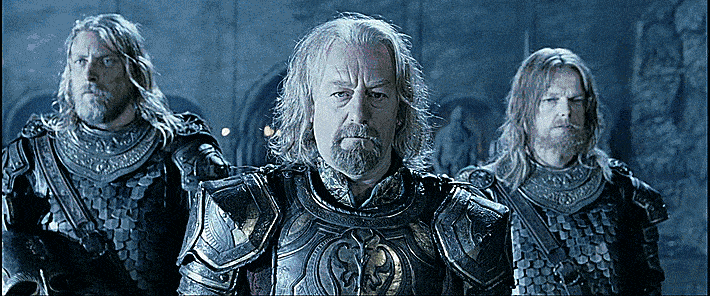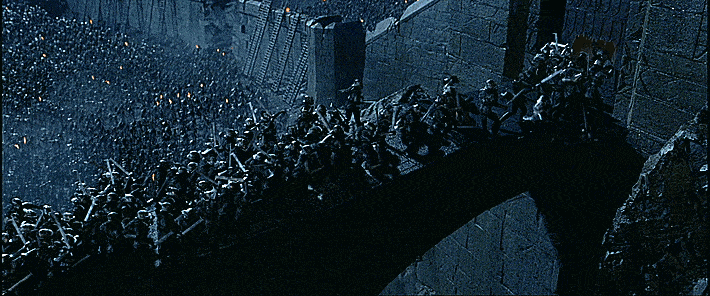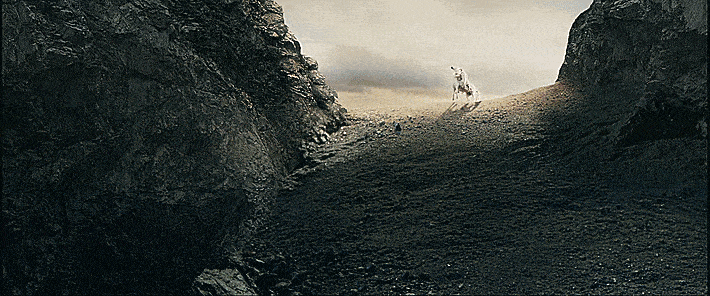The battle of Helm’s Deep is the first major battle in the War of the Ring and serves as the climax for the second part of the quintessential fantasy trilogy: The Lord of the Rings: The Two Towers. It ends in victory for Mankind, but that victory was far from assured. As the heroes slog through rain and mud against an otherworldly foe, so did the cast and crew slog through months of difficult night shoots to finish this cinematic masterpiece. The result of their effort is one of the greatest battles in cinematic history.
After the burning of the Westfold, Théoden King (Bernard Hill) takes his people to the stronghold of Helm’s Deep. It is nested within a steep canyon, meaning that the enemy can only attack them head-on. Théoden seems confident that this will be enough to protect his people and he boasts that the Deeping Wall has never been breached. But when Aragorn (Viggo Mortensen) brings news that 10,000 of Saruman’s Uruk-hai are en route to eradicate Rohan’s people, the King begins to despair. Throughout the battle, the defenders must fight against that hopelessness as they are forced to retreat again and again in the face of overwhelming odds.

Taking place almost entirely at night and in the rain, the sheer scale of this battle sequence was unheard of in film at the time. Filming it was entirely another kind of struggle. It took three and a half months of freezing night shoots to finish the sequence. On nights when there was no precipitation, gallons of water was rained down upon the cast. To keep the scene intelligible, a misty blueish backlight was used, ostensibly emulating the light of the moon. As a result, the action and actors expressions remained remarkably clear in the dark (looking at YOU, Game of Thrones).
Seventeen years later, the effects of this battle hold up surprisingly well. This is partly due to the sheer number of practical effects used. The Uruk-hai were created from makeup and prosthetics rather than mocap and CGI. As a result, they look as good now as they did at the turn of the millennium. Multiple sets were used to film this battle: a scale fortress built in a disused quarry and two smaller scale models (1/4 scale and 1/85 scale) for distance shots. The Two Towers swept the first annual awards from the Visual Effects Society, claiming two-thirds of the awards it qualified for.
MASSIVE (Multiple Agent Simulation System in Virtual Environment) is a software that was developed specifically for the Lord of the Rings trilogy to handle the massive crowds needed for these battle scenes. It has been used ever since in a variety of films and television including 300, Buffy the Vampire Slayer (in the finale episode, “Chosen”), and the Hobbit films. This software used a kind of AI to determine how each member of the crowds needed to move. “When these characters are in groups they need to ‘see’ and ‘hear’ what’s around them,” said visual effects supervisor Jim Rygiel, “MASSIVE has both artificial sight and hearing to aid in that process.”
In J.R.R. Tolkien’s novel, the Battle of the Hornburg (called the Battle of Helm’s Deep in the film) is not nearly as large in scale as Peter Jackson’s adaptation. It serves as one of several battles that lead up to the final climax at the Battle of Pelennor Fields. However, Jackson made a choice to beef it up as the climax of The Two Towers, which helps the film exist as a standalone storyline. This battle has a full narrative arc within itself indicative of the themes of the overall series narrative. Clocking in at 39 minutes long, it is almost a movie within a movie.

Despite his changes, Jackson stayed true to the core message from Tolkien’s series. Théoden spends the battle on the brink of despair, first putting up a brave face for his troops, but slowly succumbing as his people are forced to retreat again and again. Serving as a microcosm of the entire series, the protagonists here stand face to face with overwhelming evil. Against an army of 10,000 bloodthirsty Uruk-hai, beaten down by darkness and rain, they face extinction as a nation and as a race.
Spoken by Bernard Hill in Lord of the Rings: The Two Towers:
“Where is the horse and the rider?
Where is the horn that was blowing?
They have passed like rain on the mountains,
like wind in the meadow.
The days have gone down in the West,
behind the hills… into Shadow.
How did it come to this?”
Throughout the battle, these moments of despair are belied by small victories. The arrival of an army of elves from Lothlórien nearly doubles the defensive force. Gimli (John Rhys-Davies) and Aragorn manage to fight off the Uruk-hai long enough for the gate to be reinforced. Despite these moments of triumph, they find themselves barred in a falling keep as the sun begins to rise.
This battle serves as a lesson in leadership for both kingly figures present –Théoden chides Aragorn for fear-mongering about their chances before the battle, and later in their hour of darkness, Aragorn reminds him of what they stand for. The battle is a message about moral conviction standing in the face of reckless hate, and it serves to strengthen them for the rest of the campaign against Sauron. As the sun rises, Aragorn and Théoden decide to ride out in a final stand against the forces of Saruman. Providing one of the most iconic visuals of the entire series, Gandalf (Ian McKellan) arrives with promised reinforcements as the sun crests over the rise. They seem to ride the sunlight down unto the forces of darkness, putting the Uruk-hai to rout.

The Battle of Helm’s Deep remains one of the best fantasy battles in film history. Visually stunning, it has held up well to the test of time. Although it sounds like filming the sequence was an ordeal, the passion with which the cast and crew followed through with the battle shows in its emotional resonance and attention to detail. It serves as a worthy climax to the second chapter of Tolkien’s The Lord of the Rings trilogy and sets up the characters for the rest of the War of the Ring.
The post Now for Wrath, Now for Ruin: Hope and Despair at the Battle of Helm’s Deep appeared first on Film School Rejects.


0 comments:
Post a Comment